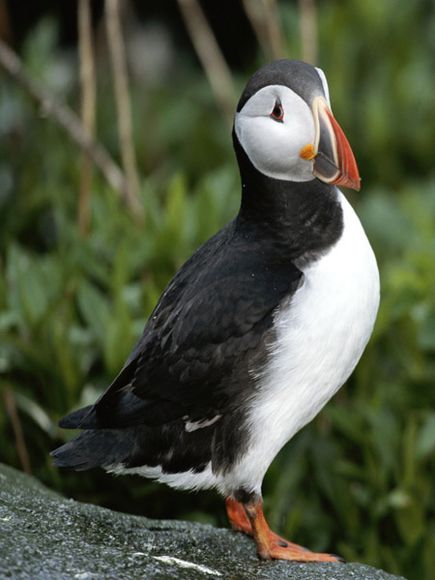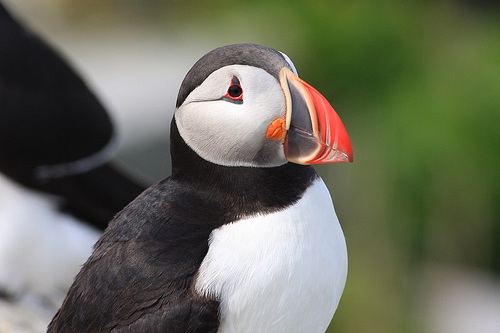
Fratercula arctica
TAXONOMY
Fratercula arctica Linnaeus, 1758, Norway. Three subspecies.
OTHER COMMON NAMES
English: Atlantic puffin; French: Macareux moine; German:
Papageitaucher; Spanish: Frailecillo Atlбntico.
PHYSICAL CHARACTERISTICS
11–14.6 in (28–37 cm); 10.6–21.1 oz (300–600 g). Distinctive
large, triangular, mostly yellow and orange bill with bluish gray
base; yellowish mouth and tongue. White to grayish face, black
band from forehead to nape, grayish chin. Mostly black upperparts;
snowy white underparts; orange to yellowish orange legs
and feet.
DISTRIBUTION
The puffin winters at sea in the North Atlantic and breeds on
the American and European coasts. Range includes the Baltic
Sea and eastern Mediterranean.
HABITAT
Marine areas near rocky coasts and islands with suitable conditions
for digging burrows.
BEHAVIOR
A strong flier, the puffin is rarely seen near land except during
the breeding season. The adults give moaning or bellowing
calls. While at sea, puffins have been known to gather in
groups with murres and razorbills, although the puffins tend to
stay on the periphery of any mixed gatherings.
FEEDING ECOLOGY AND DIET
Puffins eat mainly fish. The species is known for its habit of
packing dozens of small fish crossways in its bill to bring back
to its young.
REPRODUCTIVE BIOLOGY
Couples engage in mating displays in which they tap their
prominent bills together. Mating takes place at sea. Puffins
nest at the far end of long passageways, which they dig with
their beaks and talons into the loose earth covering the rocks.
Breeding places may be on crags close to the sea, or several
hundred meters removed from the coast. The single egg shell
is white and has almost invisible dots. The nestling wears a
“furry” down that is dense and soft. Fledglings leave the nest
after 36–47 days.
CONSERVATION STATUS
Not threatened.
SIGNIFICANCE TO HUMANS
None known.
Other popular Animals
Photo Gallery of - Puffin




 Animalia Life
Animalia Life